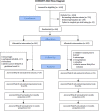Effect of a prenatal lifestyle intervention on physical activity level in late pregnancy and the first year postpartum
- PMID: 29176762
- PMCID: PMC5703566
- DOI: 10.1371/journal.pone.0188102
Effect of a prenatal lifestyle intervention on physical activity level in late pregnancy and the first year postpartum
Abstract
Background: Despite documented health benefits for mother and baby, physical activity (PA)-level tends to decline in pregnancy. Overweight/obese and physically inactive women are two selected groups at increased risk of pregnancy complications. Thus, efficient strategies to maintain or increase PA-level in pregnancy and the postpartum period, especially among these women, are warranted. This secondary analysis examined the effect of a prenatal lifestyle-intervention on PA-level in late pregnancy and the first year postpartum, with subanalysis on initially physically active versus inactive and normal-weight versus overweight/obese women.
Method: The Norwegian Fit for Delivery (NFFD) randomized controlled trial included healthy primiparous women with singleton pregnancies and body mass index (BMI) ≥19 kg/m2 assigned to an intervention group, n = 303 (twice weekly group-exercises and dietary counseling) or a control group, n = 303 (standard prenatal care). The International Physical Activity Questionnaire short-form was used to assess PA-levels at inclusion (mean gestational week (GW) 16), GW 36, and six and 12 months postpartum.
Results: At GW 36, a positive intervention-effect with a significant between-group difference in total PA-level compared to time of inclusion was found for the total group (530 MET-min/week, p = 0.001) and the subgroups of normal-weight (533 MET-min/week, p = 0.003) and initially active women (717 MET-min/week, p<0.001). Intervention-effect was dependent on exercise-adherence among overweight/obese and inactive women. Compared to time of inclusion, the intervention groups maintained total PA-level at GW 36, while total PA-level decreased in the control groups. The PA-levels increased postpartum, but with no significant differences between the randomization groups.
Conclusion: The NFFD prenatal combined lifestyle intervention had a significant effect on TPA-level in late pregnancy among women entering pregnancy normal-weight or physically active, thereby preventing the downward trend typically seen during pregnancy. Intervention-effect among overweight/obese and physically inactive women was, however, dependent on exercise-adherence. Long-term intervention-effect was not observed in the postpartum period.
Conflict of interest statement
Figures





References
-
- ACOG. ACOG Committee Opinion No. 650: Physical Activity and Exercise During Pregnancy and the Postpartum Period. Obstet Gynecol. 2015;126(6):e135–42. doi: 10.1097/AOG.0000000000001214 . - DOI - PubMed
-
- Health NDo. Physical activity guidelines in pregnancy. https://helsedirektoratetno/folkehelse/fysisk-aktivitet/anbefalinger-fys.... 2014.
-
- U.S. Department of Health and Human Services PAGAC. Physical Activity Guidelines Advisory Committee Report. http://www.health.gov/PAguidelines/Report/: 2008. - PubMed
-
- Di Mascio D, Magro-Malosso ER, Saccone G, Marhefka GD, Berghella V. Exercise during pregnancy in normal-weight women and risk of preterm birth: a systematic review and meta-analysis of randomized controlled trials. Am J Obstet Gynecol. 2016. doi: 10.1016/j.ajog.2016.06.014 . - DOI - PubMed
-
- Garnaes KK, Morkved S, Salvesen O, Moholdt T. Exercise Training and Weight Gain in Obese Pregnant Women: A Randomized Controlled Trial (ETIP Trial). PLoS Med. 2016;13(7):e1002079 doi: 10.1371/journal.pmed.1002079 ; PubMed Central PMCID: PMCPMC4961392. - DOI - PMC - PubMed
Publication types
MeSH terms
LinkOut - more resources
Full Text Sources
Other Literature Sources
Medical
Miscellaneous

